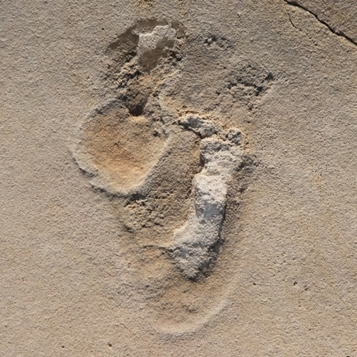Oldest footprints of pre-humans were found in Crete and dated
with participation of Bremen paleomagnetist Edoardo Dallanave

The footprints from fossilized beach sediments were found near the west Cretan village of Trachilos. Using magnetostratigraphy and micropaleontology, researchers have now dated them to 6.05 million years before the present day, making them the oldest direct evidence of a human-like foot used for walking. The tracks are almost 2.5 million years older than the tracks attributed to Australopithecus afarensis (Lucy) from Laetoli in Tanzania. This puts the Trachilos footprints at the same age as the fossils of the upright-walking Orrorin tugenensis from Kenya.
Six million years ago, Crete was connected to the Greek mainland via the Peloponnese. Several years ago, Professor Madelaine Böhme´s team identified previously unknown pre-human species in what is now Europe on the basis of fossils from 7.2 million-year-old deposits in Athens, just 250 kilometers away.
The study furthermore confirms the model according to which six million years ago the European and Near East mainland were separated from humid East Africa by a relatively brief expansion of the Sahara. Geochemical analysis of the Trachilos sediments suggests that desert dust from North Africa was transported there by wind. The team arrived at an age of between 500 and 900 million years before present when dating dust-sized mineral grains. These time periods are typical for North African desert dust.
Recent research in paleoanthropology also suggested that the African ape Sahelanthropus could be ruled out as a biped, and that Orrorin tugenensis, which originated in Kenya and lived 6.1 to 5.8 million years ago, is the oldest pre-human in Africa. Short-term desertification and the geographic distribution of early human predecessors could therefore be more closely related than previously thought. On the one hand, a desertification phase 6.25 million years ago in Mesopotamia could have initiated a migration of European mammals, possibly including apes, to Africa. On the other hand, the second-phase sealing off of the continents by the Sahara 6 million years ago could have enabled a separate development of the African pre-human Orrorin tugenensis in parallel with a European pre-human. According to this principle, called ´desert swing´ by Böhme, successive short-term desertifications in Mesopotamia and the Sahara caused a migration of mammals from Eurasia to Africa.
Further information:
Edoardo Dallanave
Phone: 0421-218-65313
e-Mail: edoardo@uni-bremen.de
https://www.nature.com/articles/s41598-021-98618-0

